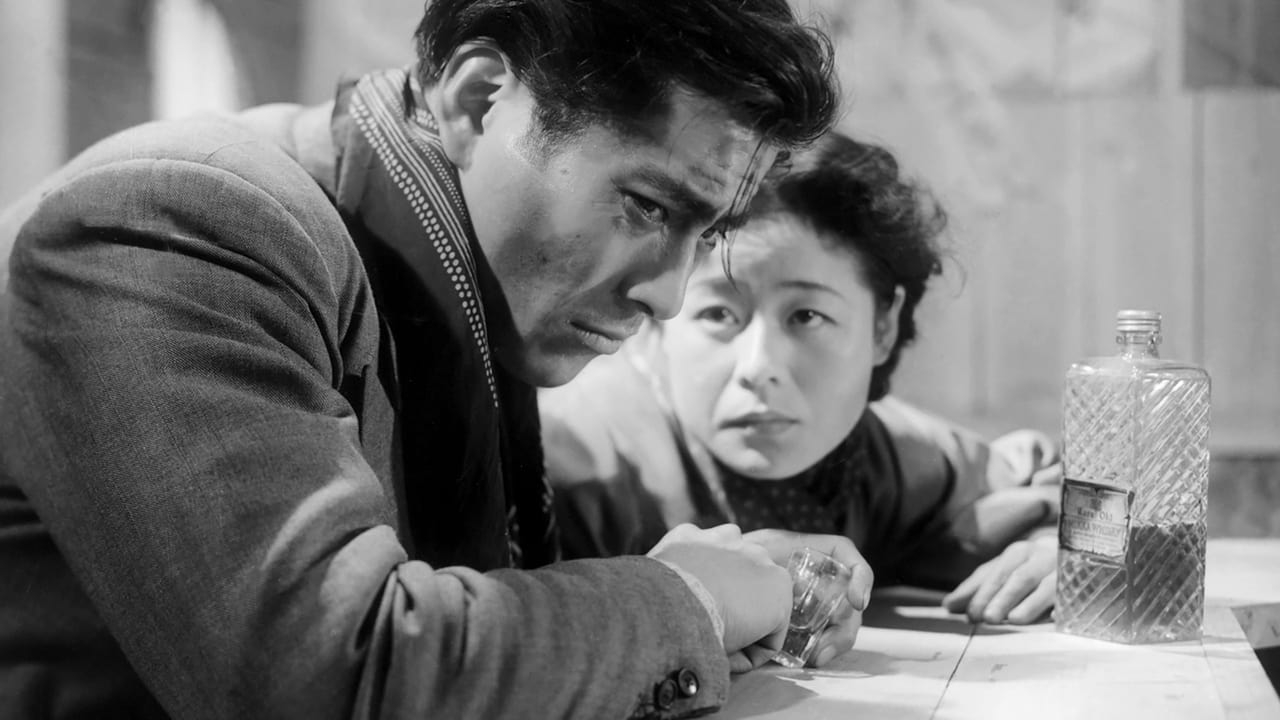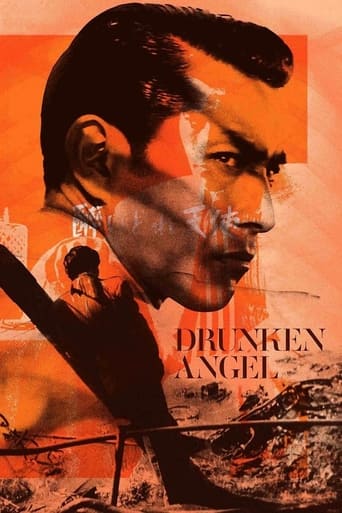

This is my third (proper) viewing of Kurosawa, and although each previous experience left enough of an impression on me to anticipate the next one, and although almost a year later images of The Hidden Fortress (1958) are still burned in my mind and playing like a permanent slideshow, only now something has really clicked with me. Like the best music albums that slowly unfurl their layers after repeated listening, my relationship with Kurosawa has now progressed beyond admiration to borderline love. Even Rashomon (1950) took a while to settle in my mind before I could fully comprehend exactly what it was doing and why I couldn't leave the thought of it alone. Kurosawa had such a masterful command of film that each and every moment feels alive, and not just kinetic but thoughtful. A scene here that I immediately recall is one in the dance hall which much of the action revolves around, in which the camera is tightly focused on a corridor, and we see our resident gangster Matsunaga (Toshiro Mifune) drunkenly stumble in, barely supported by two cronies, and then quickly pulled off frame. The camera waits for the rest of the flood of people to issue in, before pulling back along the corridor and stopping at a table of women, who talk of Matsunaga and his company, who are just off-screen. Just describing this scene does little much to illustrate its importance, but it significantly raises the drama and captures the chaos of the environment in a single interesting shot: our character has been warned not to drink and has been actively resisting the temptation, his being dragged off screen in pathetic stupor helps only adds to his increasing helplessness that we the audience share with him and the choice to suddenly stop on this group of women cleverly allows a piece of exposition to be delivered about a character in the form of relished gossip without artificially slowing the action down. Maybe what makes Kurosawa more readily accessible, on a superficial level at least, is how intertwined he seems to be with Western culture. Whether the film is borrowing elements from the West, or what you're seeing is the original prototype that was taken and remade in Westernized form, ala Seven Samurai, it's hard to escape the meeting of cultures in his work. Not that you'd want to. Here, the film takes place in a more immediate Post-WWII setting, and so the streets and its inhabitants are infused with a foreign presence; some signs are English, the gangsters dress and posture like Americans, and the malaise of recent war is still in the air, relayed to us through the cranky and cynical Doctor who really, it appears, just wants to help and hearten his fellow people. There sits a wide stagnant pool outside his office that Kurosawa's camera frequently returns to, and the Doctor at one point tries to warn off a group of children gathered around it, his aged, grumpy presence masking the fact, to the children at least, that he doesn't have to warn them of the typhoid they'll get for hanging around such places. This compassionate man is played impeccably by Takashi Shimura, who I've learned to be a Kurosawa regular. He is both cantankerous and quietly sensitive. He struggles with alcoholism but is entirely dedicated to his job. Shimura has this wonderful lower lip which works to great comic effect and can earn our sympathy easily; sometimes he looks so indignant at the happenings of the world, others he blusters and bumbles and drags it across the top of a glass loaded with alcohol. This Doctor is visited one night by an injured man, Toshiro Mifune, who it turns out is a gangster with a threatening case of TB, and an odd bond is solidified between them that comes not so much from friendship as it does just their yearning need to exist; the Doctor needs to help his patient and the patient knows, despite all his posturing, the he needs the Doctor. Mifune is like lightning here, striking at every turn and always carrying some threat of destruction. But that destruction isn't so much outward violence as it is him slowly killing himself. Much of the pathos in the film comes from seeing him ever so slowly and consistently deteriorate, until it seems like there is hardly anything left of him. Toward the end of the film, when Matsunaga realises he has been stripped of all power and is effectively waiting for his own grave to be filled, he has so little strength his body can barely take the realisation; his hanging limbs and ghoulish frozen face seem to call back to the Silent era of bold theatrical movement, and in fact in the pale desperation of his face I was reminded of Cesare from The Cabinet of Dr Cagliari. This film runs at little over 95 minutes and Kurosawa keeps the relatively simple story alive in every frame, and is filled with wonderful touches. In the first half of the film, a street musician regularly plays a mournful piece on his guitar at night, the same rhythm and the same place each time, and the world feels repeated and cyclical. When a recently released Gangster returns from prison, he asks for the guitar the musician has and plays his own piece; not just hearkening his own arrival to the world but announcing the film's shift into the second half and the darker place it is taking us and its characters. This includes a haunting fever dream of two Mifunes and final confrontation that is reckless and intense and pathetic and in its spontaneity feels proto-Godard (without the pretension). This is Kurosawa's eighth film but what he considered his first, and it is clear that he has taken away the experience from those seven previous features and distilled it into something entirely his own; a clear indication of all the masterpieces to come.
... View MoreConsidered by many to be Kurosawa's first film (actually his eighth) of real note, I watched it as part of the newly released BFI Kurosawa Crime Collection.I found it more accessible and initially enjoyable than his later and more well known samurai classics, probably because it could have been directed by Howard Hawkes or any number of leading crime flick directors of the period. With Toshiro Mifune (in his first of many Kurosawa roles) dressed in sharp suits and slicked back hair, he looks every part a Chicago gangster. Jazz bands play in bars, with western style dancing.Takeshi Shimura (another Kurosawa regular) plays the drunk doc, who despairs at the slums around him and the typhoid-infested pond that everything is dumped into that is on his doorstep. He takes a bullet from the younger man and then treats his TB. As both men lurch unsteadily from their respective curses (Mifune soon looking very haggard and unwell) and the two men form an uneasy alliance. Then the yakuza's plot is taken away from him, due to his ailing health.Drunken Angel displays not only a sharp snapshot on post-war Japan and western influences but nuanced and fine performances and a great story of two very different men, who find maybe that the differences aren't so great, after all.
... View More'Drunken Angel' is uncompromising in the way it explores a cruel reality. Post-war Japan was hardly the nicest of places and the still dilapidated capital is represented here by a festering pond of contaminated water that is compared to a swamp. In this environment a very rough doctor with the habit of overindulging in alcohol strikes a troubled friendship with a young yakuza suffering (and in denial) from tuberculosis.Unlike so many movies featuring mobsters this does not focus on gun fights and action. Instead it's a character study of a young man who despite his feisty personality is still naive enough to believe in ideas of honor and value in the world of the yakuza. The movie's loyalty to realism demolishes these illusions in a convincing and poignant way.Apart from psychological development on a personal level there is also a bitter but lucid social critic on a society that expects women to submit to men as slaves and where bullying the weak is part of the status quo. Men too are victims of a system that forces them not to express weakness or fear at any times to the point they are cornered into self destructive behavior.But there is no easy moralizing or cheap redemptions to balance the pervading darkness. Which is not to say that this is a movie completely without hope. But it is a reasonable hope, the kind that is rooted in the uncompromising reality that limits it considerably. And perhaps for that very reason it seems so precious.Tragedy is done without dramatic fanfare and strikes a chord precisely for that. Disease, both of the body and of the soul, is shown with all its brutality and almost seems to be a symbol of an overall decadence that covers Tokyo. The strict realism is only interrupted by a dream sequence that is haunting in the extreme.'Drunken Angel' relies almost solely on the dynamic between the two leads played by Mifune and Shimura. Their interaction is full of conflict but laced with affection as well. An unlikely hero in the figure of the doctor and an unlikely yakuza in Matsunaga, the match is odd and rough around the edges. And that, too, results in a coherence of lucid and moving realism.
... View MoreHappy encounter between master Akira Kurosawa and Toshiro Mifune great actor. Started the shooting of the film, the script was fully focused on the character of Dr. Sanada, a temperamental physician, sharp and heavy drinker, but at the same time noble and condescending, who played the wise actor Takashi Shimura, member of the filmic family of Japanese director. It was to show the ambivalent relationship of singular physician with some of his patients, and Mifune's character, a gangster named Matsunaga, who arrives to take you off a "nail", was intended as one more among Sanada's patients... but behold, the amazing performance of Toshiro delighted the visionary director leaves, and soon, his character is extended to the point of putting one on one with which interprets Shimura. And thus would begin a relationship that would lead to outstanding a number of films that are today the most significant part of which gave us the Far East ("Stray Dog", "Rashomon", "Seven Samurai", "Throne of Blood", "Yojimbo", "Red Beard"...).The story is set in a poor village, where gangsterism is a source of survival and power. The rain water inundated streets unpaved, and the mud then, becomes a leitmotif for Kurosawa reveals the sinking of being in the midst of alcohol and irresponsibility, and perhaps, the abandonment of a State for all miss opportunities.The Sanada and Matsunaga characters, move in an interesting love-hate, I accept you-you rejection, live and die, that accounts for human ambivalence where what seems is not as it seems.The doctor's character is also quite interesting, because he realizes the man with no pretensions, no worries of enrichment, and the ability to perform so naturally, falls in the act shamelessly unfair, in the sentence harsh and in the alcohol allows him to escape, at times, a reality that don't is offering great prospects. It is thus a portrait of ordinary people, viewed sympathetically and with the clearest assessment features. It is clear that Kurosawa, knew well the people.
... View More